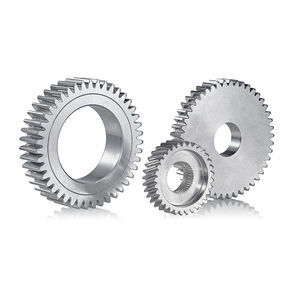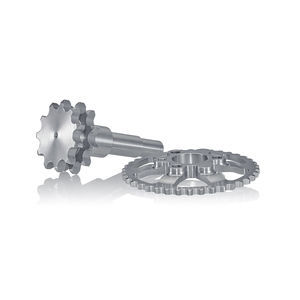
- Power Transmission - Mechanical components
- Mechanical Transmission
- Spur gear
- Zahnradfabrik Hänel GmbH & Co. KG

- Products
- Catalogs
- News & Trends
- Exhibitions
Spur gear helicaltransmission


Add to favorites
Compare this product
Characteristics
- Type
- spur
- Teeth
- helical
- Applications
- transmission
Description
Helical gears are also known as diagonal spur gears or screw gears. They are spur gears with angular teeth. They are mounted on shafts in parallel or crosswise at an helix angle of up to 90°.
These gears are installed in helical gear drives, which are mechanical, positive locking gearsets. The driveshafts in helical gear drives have a skewed orientation. In other words, the driveshafts in the helical gear drive are neither parallel to one another, nor do they have a point of intersection like the axis of a bevel gearset. Unlike worm gear drives, in which the driveshafts are also skewed, the helical gear drive is equipped with helical gears on both axis. This configuration results in a lower gear (transmission) ratio.
When rolling off in a fashion similar to screw threads, the teeth of helical gears touch at one point only. This contact at the involute of the gear teeth makes the helical gear drive better suited for the transmission of smaller forces rather than larger ones. A maximum transmission ratio of 1:5 is possible.
The constant sliding friction between the meshing teeth of helical gears can result in faster wear. This issue can be resolved through the use of additives in the lubricant.
The advantages of helical gearsets include very smooth operation and low noise levels. In applications having a constant increase or a constant decrease in the transmission of power, the paired teeth engage gradually. Thanks to this special meshing, the transmission of torque is smoother with helical gears as opposed to gears that do not have diagonal teeth.
Other Zahnradfabrik Hänel GmbH & Co. KG products
Products
Related Searches
- Straight-toothed sprocket wheel
- Chain sprocket wheel
- Helical gear
- Spur gear
- Metal sprocket wheel
- Steel sprocket wheel
- Precision shaft
- Shaft gear
- Cylindrical gear
- Precision gear
- Single shaft
- Transmission shaft
- Transmission gear
- Stainless steel sprocket wheel
- Internal-toothed gear
- Stainless steel gear
- Drive shaft
- Single sprocket wheel
- Triple sprocket wheel
- Flange sprocket wheel
*Prices are pre-tax. They exclude delivery charges and customs duties and do not include additional charges for installation or activation options. Prices are indicative only and may vary by country, with changes to the cost of raw materials and exchange rates.









